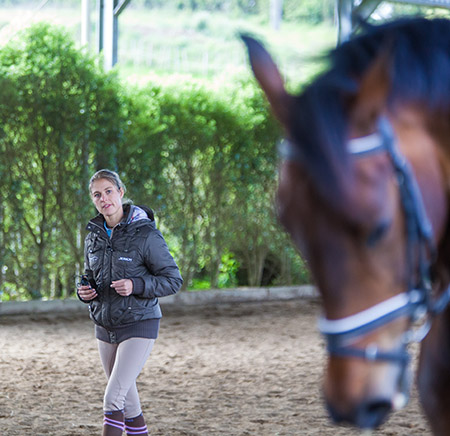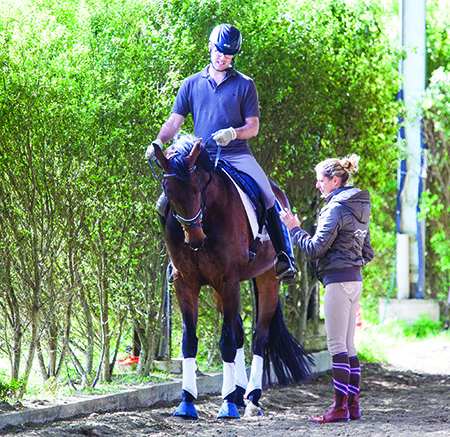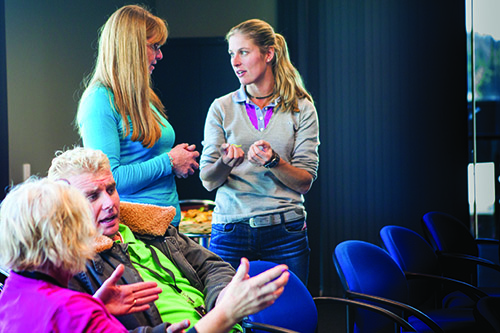by Rebecca Ashton
Ever spent time with someone who possesses high energy and super positivity? Know how contagious that can be? Spend some time with Dutch dressage superstar Adelinde Cornelissen and you’ll know what I mean. I had the great opportunity to hang out with the London Olympic dressage individual silver medalist in New Zealand where she was a guest presenter at Equidays, the Kiwi equivalent of our Equitana. She gave two masterclasses and some private clinics in the Hamilton area.
Adelinde’s training system is simple but not always easy. Subtle changes and awareness of both the horse and the rider’s own body takes great focus and concentration. “If you give your horse your full attention, they will give you their full attention back,” encouraged Adelinde.
Like all good riders, Adelinde has a structure for her sessions. Before each lesson started, she would ask the rider what their goal was and their plan for the lesson. “You cannot train without a goal”, each student was told, “It doesn’t need to be going to Rio and winning gold. Make a plan, not just long term but everyday. It’s only fair to the horse. It might just be that he starts relaxing with a hack outside. You don’t want to be on for 45 minutes and then think, ‘Oh, I wanted to do piaffe’.” There were some interesting goals from the riders such as Christine Weal on Ragazzo who just wanted to stay on, causing Adelinde to chuckle.
The Dutch rider’s positive attitude was never far away either. When Gaylene Leonard complained, “We’re never good enough. That’s the problem,” Adelinde replied, “No, it’s not a problem, it’s a good thing. Never be satisfied. But don’t work twice as hard as the horse to get it.”
Once goals were established, it was all about the basics. Nothing new, but all too often riders were more interested in holding their horses together getting straight into collected work. Speed control, balance and rhythm were the key ingredients. Every single horse started with the same test that all three areas were well under control. “Speed control; you can never forget this for the rest of your life. It is the most important thing!” emphasized Adelinde. If a horse has a problem with a movement, it is never the movement but the speed control, rhythm or balance.
It is only after these basics are firmly established that a rider can move on. “You have to ask yourself: What in the end do we really want from our horses? Why do we train them? I want to shape it and make an athlete out of it so when I compete, it can do it as easily as possible,” explained the Dutch rider.
With the young horses, just fitness was necessary at first, then flexibility and only after that power and stamina.
“The fitter the horse is, the easier it is for it to do the work. Then it is also more fun for him. Don’t always train the difficult things. Imagine if you went to work and all day you had to do something you didn’t like or couldn’t do. You would hate it. So, also train the things the horse finds easy and fun, especially at the end of a session,” Adelinde advised.
A lot of the young horses were not forward enough and there was more than one lesson where not much more was said than, “Forward! Be convincing. Don’t push with your seat to go forward. Just legs.” Adelinde explained further, “If they’re really back at four years of age, then by eight when they do the exercises, they’ll really start backing off too much.” With the four year olds, it was important to first just get their legs moving. It was also necessary to keep them very relaxed and keep things easy for them to build their confidence. Sharpness to the leg was also a major requirement, but not to the degree as the more advanced horses.
Then up into the canter and it was ok for the transitions at this stage to be less than perfect as long as the horse kept forward, stretching and there was a bit of steering.
The five years olds were expected to be a little better with the basics, but each lesson started the same way. The long term goal was established, then the day’s plan and then a check of the speed control, rhythm and balance. One rider received the following feedback when her downward transition from lengthened trot was too abrupt, “They have to always think forward so slow down gradually. Repeat until you really feel he is paying attention to you. This is a spooky horse, so this speed control is even more important. Don’t always do the same number of strides either. Horses are not stupid and they soon know and then it’s not your speed control anymore, it’s more his memory you are testing! And don’t always do it out of the corner and forward on the diagonal and slow at the end.”
The lessons also ended the same way with a relaxed, stretching trot on the long rein without any running or change of rhythm and Adelinde making quite sure that the rider understood everything from the session.
With the slightly older horses, it was then time to introduce some lateral work, beginning with leg yield. Adelinde explained, “To make an athlete out of your horse, you have to build up the right muscles in the right places, therefore we need to be able to control, isolate and flex every single part of his body.” This began with flexion in the poll without the neck or body changing at all.
Adelinde asked one rider, “Is he forward? Is he giving in the jaw? Is he giving to your inside leg? When you ask with the inside rein, just the head needs to turn to the inside. I don’t want the head to tilt. This is the hardest bit to supple up. There needs to be good co-ordination with your reins. They need to be fine tuned, another reason you need to be really focused as a rider.”
With the flexion established, it was time for shoulder in. As with all movements, once it was executed correctly, it was necessary to test the speed control within the movement before trying out the travers. When someone asked how much bending and flexing was required in each movement, Adelinde replied, “ As much as you want. For me in practice, you can ride travers on three or even four or five tracks, but it has to be your decision, not an accident. Don’t always do it like it is in the test. Have 20 different options with it. Then in a test, you can give the judge what they want to see, because then you can do anything.”
With the extended trot, it was again about, you guessed it, speed control. “I build up the extension from speed control. You want the weight back on the hind legs and just the legs move forward so it is easier for the front legs to come up. Then it’s just a matter of trust and confidence that he can keep the front legs up for longer. If you can try it also out in a field where the horse is more excited, it can be easier,” was Adelinde’s advice. For those that couldn’t quite get it, there was some comfort, “Parizival has only really done a proper extended trot for the last three years because now he is really on the hind leg. He is 16, so don’t worry so much with your eight year old!”
When the work got harder, horses’ necks started to get too high and block the movement. It was then that the touchy subject of neck position was addressed. Adelinde explained, “The more advanced the horse, the more balanced it is, the more you can play with the neck position. With a four year old, you leave it and never ask it too low. The older horses though, you are testing the balance. You can only bring the neck down if the weight is on the hind quarters. It is the only time it is useful. Because he drops the neck to get more stretch, if the hindquarters aren’t under, there can be no stretching of the top line.”
With all the horses, Adelinde wanted to see the top of the neck stretching away from the hand. And behind the vertical? “Don’t worry about it too much, but they still have to respond to the leg to go forward and not hide behind the contact.”
When Andrea Martin’s flashy Sandro Hit was showing it’s big trot, Adelinde remarked, “Speed control. Think a small trot, a pony trot, not a passagey trot. Drop his neck. You can see he has talent for the passage, but you need to keep the trot rhythm. You should give one leg aid and the horse should react forward. He needs to be sharper. He starts to think backwards and then you get the passagey trot. Now flexion and keep the neck straight and keep the top of the neck away from you. You can only get the small trot if the top line is not stiff. Now he is more supple and softer in the top line. Every single stride giving with the hand. Even when you start collecting, you always have the feeling that you could ride forward.”
This was hard for the horse and Adelnde brought up her training principle, “Do you train when you do everyday the same thing you can do? Not really. Training only starts when you’re out of your comfort zone. So, repeating the same thing everyday is not training.”
Britta Pederson on her black Upendo also had this pointed out when Adelinde wanted the horse sharper and quicker in the one tempis, “You’ve changed the technique now and you get a mistake because he’s now out of his comfort zone. That’s ok, it happens when you want to get better! You just have to go through that. Don’t care about mistakes. I can’t say that often enough. If you’ve never made mistakes, you’ve never done something harder than you can do,” encouraged Adelinde.
Gaylene Leonard aboard Donzello also garnered some advice about the one tempis when she explained she had only touched on them. “With the ones, if you can do three, you can do 15,” Adelinde clarified, “So do 1, 2, 3 and then test speed control forward and back. It’s nice that the horse wants to do it, but he must not anticipate. You have to be in control. Always ask, is it you that does the 15 or is it the horse?” It was all a mental game”
Adelinde continued her advice on the one tempis, “You have to feel the rhythm in your butt, so don’t tense it. Relax your seat and get the horse forward with your leg.” Gaylene achieved this for a while before returning to her strong ways. “Why are you working again?” asked Adelinde. The rider proceeded to hit her head as her own reprimand. “Exactly. Hit yourself!” encouraged her trainer jokingly.
When Julie Brougham on her fabulous chestnut Vom Feinsten showed some wonderful piaffe, Adelinde wanted everyone to know that the piaffe, along with the other high school movements, is not a trick. All it is is speed control. A good exercise to prepare for such collected movements was a lot of trot halt trot transitions and getting the hind legs snapping under. “You have to own the last stride. As riders, we have to be disciplined and have consistency with our aids. We expect the horse to be exactly the same each time. We must be too,” reminded Adelinde.
After all the collected work, riders were told that if you collect, you have to stretch. “Don’t just collect, collect, collect! Stretch as well. Especially in the walk. How many Grand Prix horses do you see that still have a good walk? Not very many. Don’t forget the walk is times two. That’s a big difference between winning and losing!”
What was different about Adelinde and many other instructors was her attention to the rider; their position, effectiveness and influence on the horse. Body awareness was key, “Make sure you’re not telling the horse to do something with your body that you don’t want him to do,” she instructed.
She also focused a lot on the rider’s breath and its role in softening the body and lowering the rider’s centre of gravity. This makes the rider a much easier load for the horse to carry.
When young Amanda Berridge had to deal with her pulling, big chestnut, Adelinde helped, “Relax your thigh, knees and butt. If you grip you can brace against him so he will just get stronger. Balance and be soft and instead get him on his hind legs. Speed control!” She wanted all the riders to release the tension in their muscles and unblock their hips by not hollowing their backs.
Not until the rider’s body is relaxed, soft and under perfect control can the rider be consistent with their aids and do as little as possible. It is because of this that Adelinde has been an enormous advocate of rider fitness. “It is the most important thing!” she stressed. In next month’s magazine, Adelinde explains her approach to rider fitness and what riders can do to completely change and improve their technique.
Thanks go to Equestrian New Zealand and Scott McKenna for convincing one of the world’s best equestrians to take time out of her crazy schedule and head south, and also to Adelinde and her partner Sjaak for being so open and giving of their time.







